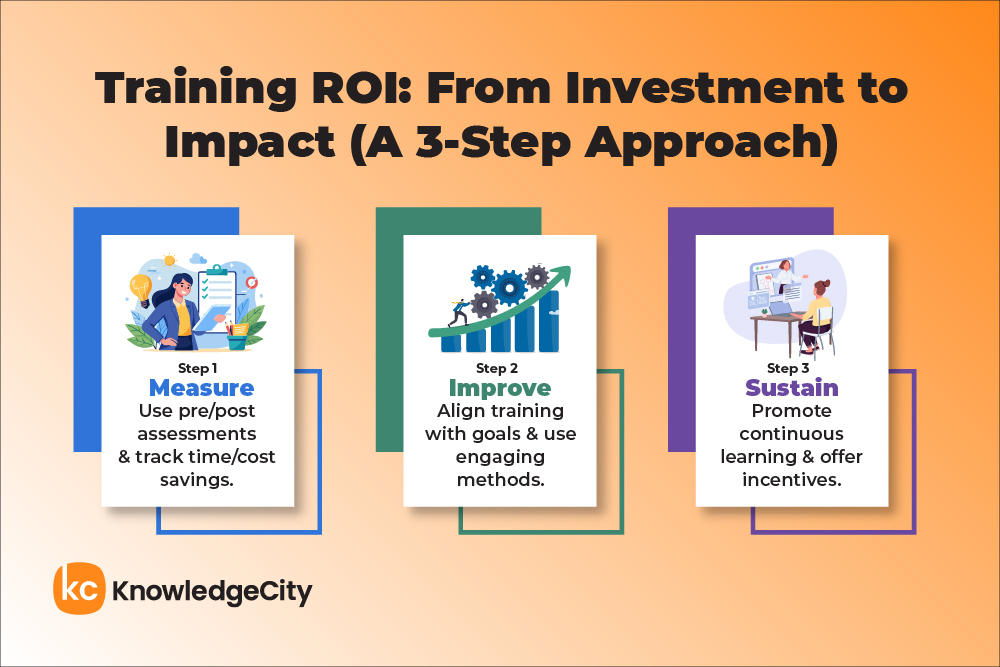Every year, businesses invest substantial sums in employee training, yet the outcomes can vary significantly. According to data from 2022, large companies allocated an average of $19.2 million to training, while midsize firms set aside around $1.5 million, and small businesses dedicated roughly $368,891.
Despite substantial investments in employee training, its effectiveness can vary. However, by leveraging technology, continually evaluating and updating training, and offering diverse learning methods, organizations can enhance the return on investment (ROI) of their training endeavors and drive success within their workforce.

In this article, we’ll explore the high cost of poor training and how you can measure and improve your training initiative’s ROI.
The High Cost of Poor Training
Inadequate training can significantly harm a company’s finances in various ways. Here are some common costs linked to ineffective training:
Well-trained employees tend to make fewer errors, work more efficiently, and boost productivity. When training falls short, it can lead to errors, delays, and decreased productivity, resulting in financial losses and dissatisfied customers.
Insufficient training can leave employees feeling frustrated, overwhelmed, and unsupported, leading to higher turnover rates. This turnover incurs costs for recruitment, hiring, and training new staff. It can also dampen company morale and productivity.
Inadequate training poses significant risks and liabilities, especially in safety-critical industries. Consider a scenario where a construction worker lacks proper safety training. This increases the likelihood of on-the-job injuries, potentially leading to costly lawsuits against the company.
How To Measure Training ROI
To gauge the real impact of training and assess its ROI, you need concrete metrics. Here’s a straightforward approach to measuring training ROI:
- Assessments Before and After Training
Before training, evaluate employees’ knowledge and skills in the targeted area. This guides your training focus and identifies gaps. After training, conduct another assessment to measure skill improvement. Comparing pre- and post-training assessments reveals training effectiveness and ROI in skill enhancement.
- Time and Cost Savings
Consider time and cost savings as indicators of training ROI. If training enables employees to complete tasks quicker and more efficiently, it translates into cost savings. Similarly, training that reduces errors saves money in the long run.
- Increased Productivity and Revenue
Evaluate how training impacts productivity and revenue. Poor training can hamper productivity and revenue generation. Assessing training’s influence on these areas helps you calculate ROI. For instance, a 10% productivity increase post-training can be quantified in monetary terms and then compared to training costs.
Who Is Responsible for Training ROI?
Training ROI isn’t just up to the training team. It demands collaboration across departments, involving HR, managers, and employees.
HR offers support and resources for training. Managers stress the importance of training and encourage employee participation. Employees take charge of their learning and development journey.
How To Improve Training ROI
Now that we’ve discussed measuring training ROI, let’s explore ways to improve it. Here are a few strategies you can implement to ensure your training initiatives are delivering a positive ROI:
- Align training with business goals
Before crafting any training programs, identify your company’s objectives. Then, customize the training to target specific needs and skills necessary for reaching those objectives. This ensures employees learn relevant information directly related to their roles, which enhances its effectiveness.
- Measure training effectiveness
Monitor how training impacts real-world outcomes. Common metrics include post-training surveys, task performance evaluations, and changes in productivity or customer satisfaction. Regular assessment helps pinpoint areas needing improvement and enables program adjustments.
- Use engaging training methods
Lectures can be monotonous. Instead, integrate interactive elements, simulations, or gamification to boost learner engagement. Active participation enhances retention and application of knowledge. SHRM reports that 32% of employees prefer training with a social element, like peer-to-peer learning or group sessions.
Recognize that employees have diverse learning styles. Provide a range of training methods, including online courses, in-person workshops, and on-the-job training. This approach caters to various preferences and enhances overall training effectiveness.
Offering a mix of training methods can help you understand which strategies are most effective and deliver the best ROI.
- Emphasize continuous learning
Develop a culture of ongoing education by offering employees resources and opportunities to update their skills. Provide microlearning modules, online courses, or subscriptions to industry publications to support this effort.
- Provide incentives for learning
Positive reinforcement is effective. Consider providing incentives such as certificates, recognition programs, or bonuses upon completing training programs. This motivates employees to take charge of their learning and development.
- Employ technology
Technology plays a vital role in enhancing training effectiveness and measuring ROI. This involves using tools for delivering and tracking training, such as learning management systems (LMS), and tools for assessing employee knowledge and skills.
For example, a customer training platform can provide interactive and engaging customer training while tracking their progress and success rates. This data can then be used to measure the ROI of the training and make improvements as needed.
- Continuously evaluate and update training
Training shouldn’t be a one-time event. It’s important to consistently assess and update training materials to be sure they stay relevant and practical. You can achieve this through regular assessments, surveys, and gathering feedback from employees and customers.
By continuously improving training, you can maintain its effectiveness and deliver a positive ROI for the company.
Measuring ROI with KnowledgeCity
Ineffective training can be expensive, causing decreased productivity, increased turnover, and heightened risk. To address this challenge, it’s important to measure your training ROI. Track the hidden costs of inadequate training, assess the true impact of programs, prioritize cost-effective solutions, and target training to specific needs. This shift from reactive to proactive training leads to a more productive, engaged workforce and a more robust bottom line.
Subscribe to Our Newsletter
Join 80,000+ Fellow HR Professionals. Get expert recruiting and training tips straight
to your inbox, and become a better HR manager.

 KnowledgeCity
KnowledgeCity 












